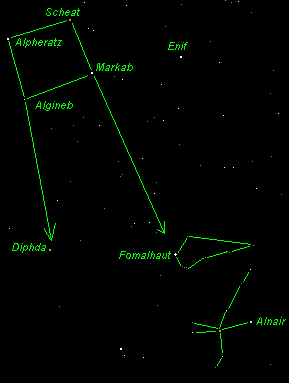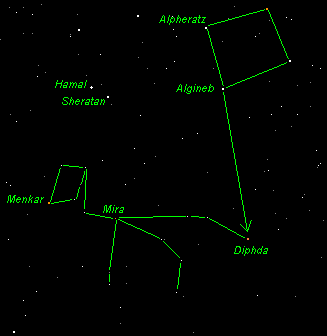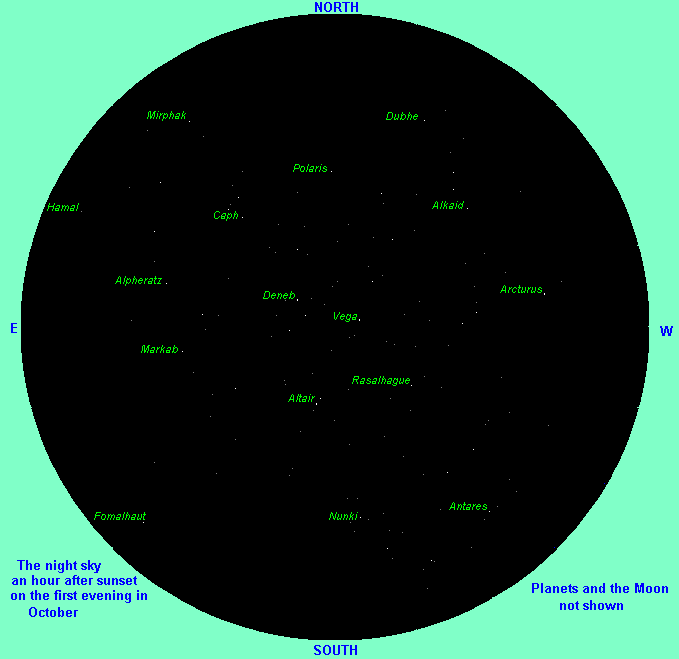The cold, clear skies of October provide a wealth of viewing
opportunities. At sunset you can still find the Great Summer
Triangle overhead but that is the only reminder of summer. The Triangle
is so far north that it stays visible throughout about half the
year, so that's not a particularly good name for it.
The view of the night sky near the southern horizon is different.
Most of the stars and constellations along the southern horizon
are only visible for a short period of time. The farther north
you live the less time you have to enjoy the southern stars. For
example, up here in Scotland, Fomalhaut is visible only for a
few weeks in the year and you cannot see Alnair at all. On the
other hand, the Scots get to enjoy the Summer Triangle a little
longer. 
Let's take a closer look at some of the stars appearing in the southeast part of our evening sky. To help orient you, start with the Square of Pegasus in the north. This is a large obvious box-shaped figure east of the Summer Triangle. A line due east from Altair will put you smack in the middle of the Square. Four bright stars mark its four corners. We will use these stars as pointers to the interesting stars rising in the southeast.
|
Imagine a line from Scheat through Markab and extend it south to Fomalhaut. Don't
confuse it with Diphda which is farther east. We'll get to that star in a moment.
Fomalhaut is the only bright star in the constellation of Piscis Australis (the Southern Fish). This constellation is boring and small but Fomalhaut certainly isn't! This is a very white star (type A) only 22 light-years away so we're practically neighbors. It's 13 times more luminous than our Sun and it really stands out with a relative magnitude of 1.2. A few years ago astronomers discovered a cloud of cool matter around Fomalhaut. This dust ring may be similar to the accretion disk from which our Solar System formed. If your latitude is far enough south you can continue that imaginary line through Piscis Australis and into the constellation of Grus the Crane. The Crane's brightest star, Alnair, is a bluish star (type B) 68 light-years away and over 200 times as bright as the Sun, but with a relative magnitude of 1.7. It's slightly dimmer (magnitude 2.1) neighbor, Al Dhanab, is a red giant (type M) and is supposed to be the center of the Crane. | 
|
As the night goes by, new stars will appear from the southeast horizon. Alnair might appear as the night sky sweeps by so, if you don't see Alnair right away, don't give up hope. If your latitude is south of the 54oN latitude, Alnair will appear - perhaps only briefly and not very far off the southern horizon, but it will rise!
As you wait for the sky to progress you can look for Diphda. You may be too far north to see Alnair but you can see Diphda, a bright (magnitude 2) orangish (type K) star, to the east and north of Fomalhaut. Diphda is the brightest star in the constellation of Cetus and it can easily be found using the other side of the Square of Pegasus (Alpheratz and Algenib) as pointers.
The stars appear to move slowly across the sky each night but
we know that this apparent motion is really caused by the rotation
of the Earth. Similarly, the stars appear to follow a seasonal
pattern of migration, with the location of the stars changing
from month to month. In fact, this seasonal change is caused by
the motion of the Earth around the Sun. Regardless, the starfield,
or "celestial sphere" is unchanged because star patterns
are unchanged during the brief life span of a human. Many people
believe that each star always shines with the same brightness
but that's not correct. 
There are lots of stars that change their brightness, sometimes very regularly and other times randomly. Some stars change their brightness for an extrinsic reason. Algol, for example, dims each time its smaller, dimmer companion passes in front of it. However, most stars that change their brightness do so for an intrinsic reason - something to do with their own astrophysics.
Mira is one such star. Mira, also known as Omicron Ceti, will rise after Diphda and it should be easy to find.
|
It's in the constellation of Cetus, the Whale (sometimes described as a "sea monster"), and you know where it lies because Diphda is in Cetus. This constellation is just to the south of Aries, the Ram, whose brightest star is Hamal (magnitude 2.3). Look for it rising in the east a couple hours after sunset.
Some people find Cetus by simply looking south of the two brightest
stars in Aries - Hamal and Sheratan. However, I think it's better
to find Cetus by starting with the Square of Pegasus. Imagine
a line from Alpheratz through Algenib and continue south to the
orangish star Diphda (magnitude 2). Once you have identified Diphda
you have found the tail of the whale. Sweep eastwards (towards
the left) along a series of stars that end in Menkar, a red star
of magnitude 2.5 that sits in the nose of the whale. Between Diphda
and Menkar, but closer to Menkar, is our target - Mira. By drawing
in these additional lines I hope you will understand how to pick out
Mira from among the rest of the stars in Cetus. It, too, is
a reddish star and it might be as bright as Menkar. Or it might be
so dim that you cannot see it at all! |  |
Mira is a long-period variable meaning it changes its brightness (that's why it's a variable) over the course of months (that's why it's a long-period variable). It was the first variable star to be identified. Mira is classified as a pulsating M-type supergiant. The "M-type" designation means it is a nice reddish color and the name "supergiant" says it all. This star is more than 100 times as large as our own Sun! It's pretty close to us too - a mere 95 light-years away. Of course it's the "pulsating" part that makes this star interesting.
|
Red giants are very old stars approaching the end of their lives.
Unlike normal stars, red giants have a core full of helium. When
this helium starts to undergo nuclear fusion, the star becomes
unstable and begins to experience waves of energy fluctuations
that cause it to expand and contract. This causes the star to
brighten and dim over time.
Many red giants fluctuate. For example, over the past few years the magnitude of Betelgeuse (in Orion) has ranged from 0.1 to 0.9. However, unlike Mira, Betelgeuse's magnitude fluctuations are not periodic. |  |
Not that you can set your watch to Mira's fluctuations. Unlike
an eclipsing variable (like Algol) long-period variables are more,
well, "variable".  We don't fully understand the astrophysics
of pulsating stars like Mira so we really cannot make accurate
predictions about when it will be at its maximum brightness. Mira's
period is an average of 331 days and it's predicted to reach its
maximum in September, but it's a bit unpredictable, so have a look for it at regular intervals. This star is full
of surprises! It has been known to grow to a magnitude as high
as 1.7 making it the brightest star in Cetus. Usually it tops
out a magnitude dimmer than that. However, that's still
plenty bright enough to be seen with the naked eye.
We don't fully understand the astrophysics
of pulsating stars like Mira so we really cannot make accurate
predictions about when it will be at its maximum brightness. Mira's
period is an average of 331 days and it's predicted to reach its
maximum in September, but it's a bit unpredictable, so have a look for it at regular intervals. This star is full
of surprises! It has been known to grow to a magnitude as high
as 1.7 making it the brightest star in Cetus. Usually it tops
out a magnitude dimmer than that. However, that's still
plenty bright enough to be seen with the naked eye.
This is a good time of the year to look for Mira. If you find it, try to watch Mira over the next few weeks as it fades away. Folks with a telescope can watch it fade to its minimum magnitude of 10. The peak brightness will occur one month earlier each year but, like I warned you earlier, Mira might reach its peak a little before or after it should.
Spend some time this month trying to find these southern stars and constellations. How far south can you see? Can you find mysterious Mira?
There are a couple meteor showers this month but they are not
very good, however, you might want to look for them anyway. The
Draconids are extremely variable but usually weak. They
are a very brief storm lasting only one day - October 9th! This
shower is the result of the parent comet Giacobini-Zinner. The
Orionids start around the 15th of October, peak on the
21st and drizzle away by the 26th of this month. This is usually
the best shower of October with as many as 25 meteors seen each
hour during the peak. These invaders are bits of Halley's comet
(perhaps you've heard of it  ) and produce fine trials that swiftly
disappear. At the end of the month the Taurids begin but even
at their peak in early November, they produce only about 10 meteors
an hour. They are the "offspring" of Comet Encke - a frequent
short-period comet well known to the comet hunting fraternity.
) and produce fine trials that swiftly
disappear. At the end of the month the Taurids begin but even
at their peak in early November, they produce only about 10 meteors
an hour. They are the "offspring" of Comet Encke - a frequent
short-period comet well known to the comet hunting fraternity.
|
Your sky map for the month of OctoberHere's a map of the clear, night sky as seen from the center of the USA on the first evening of this month, an hour after sunset. Specifically, this is the view of a clear sky from a latitude of 37N. Star-gazers farther north, such as in Minneapolis, Chicago and most of Europe, will have more of the northern sky visible and the southern sky will be obscured by the horizon. Vice versa for those who are farther south. The stars will not change position relative to each other, however, throughout the month, the Moon and planets will wander, so they are not shown. Only objects of magnitude 4.0 and brighter are displayed. Here's a reverse color image of the map that will be easier on your printer. |  |
The first record of a solar eclipse was made by Ancient Chinese astronomers. That eclipse occurred on October 22nd 2136 BC. (That's right, "BC"!)
A piece of Mars fell on Chassigny (France) on October 3rd 1815. At that time some folks were still skeptical that rocks fell from the sky, much less came from Mars. Of course the origin of this important meteorite was not determined until a few decades ago (using isotope analysis).
Edwin Hubble discovered the first Cepheid variable in the Andromeda Galaxy on the night of October 5th 1923. He used its data to prove that this "nebula" was actually a very distant star system outside of, but similar to, our own Milky Way.
On October 4th 1957 the USSR put Sputnik 1 into orbit. This first manmade object to be placed in Earth orbit was the pioneer to the many satellites that followed and caused the USA to rethink its lack of commitment to space sciences.
So, on the 1st of October 1958 Congress established the National Aeronautics and Space Administration (NASA).
On October 18th 1958 Luna 3, a space traveling satellite launched by the USSR, returned the first photos of the Moon's far side. Because we cannot see that side of the Moon from Earth, it was like pictures of a new moon. People had expected to see a lunar surface similar to the face that we see from Earth so everyone was surprised to see that the far side of the Moon is much more heavily cratered and lacks the large "mare" so obvious on our side.
Venera 9, another USSR space probe, sent back the first picture from Venus' surface on October 22nd 1975. It showed a world in which all the rocks looked orange due to the reflection of Venus' clouds. This craft also determined that the surface of Venus had a temperature over 480oC and an atmospheric pressure about 90 times that of the Earth's! Not a nice place.
I hope you found the Night Sky this Month to be helpful and educational. I invite you to return here monthly for new information.